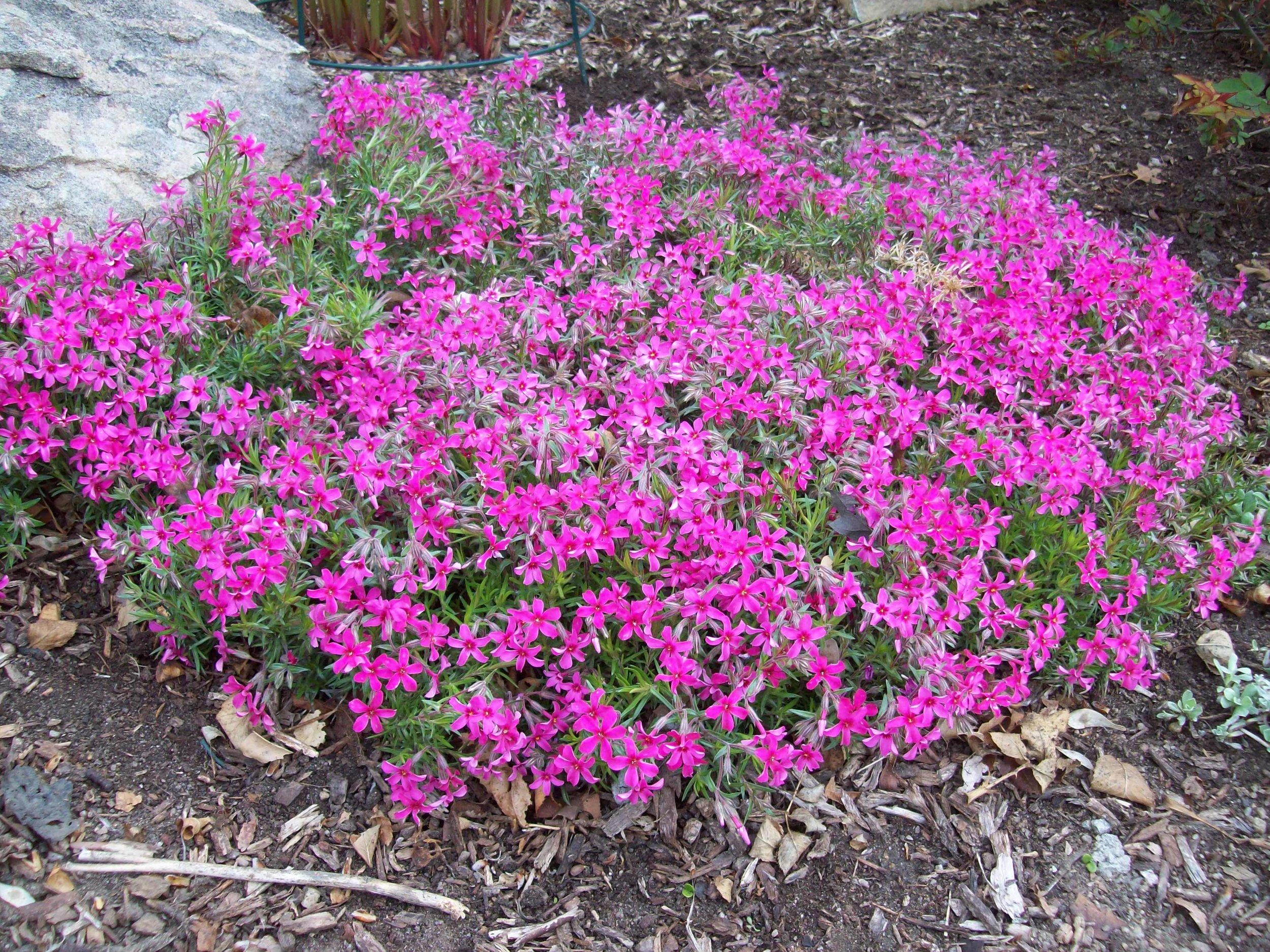Groundcovers
Groundcovers can be used as lawn alternatives or just to cover large areas of a bed or hell strip. Some make great evergreen/grey mats throughout the year while others are deciduous. Heights of groundcovers also vary from around two to fifteen inches. Some can take light traffic. Most of these can be trimmed back easily from edges or pathways.
Thymus pseudolanuginosus, Woolly Thyme
Woolly Thyme is the most drought-tolerant of the creeping thymes and forms a thick, grey, plush carpet, which can withstand occasional foot traffic. These thyme plugs were planted about 18 inches apart and it is the second year of growth. There are other non-woolly, green-leaf thymes of many flower colors that can be used as groundcovers too.
Phlox subulata, Creeping Phlox
Creeping Phlox comes in many different colors. It is an early spring blooming perennial, so it will look great with daffodils and tulips. It can look a little scruffy later in the year.
Antennaria rosea, Rosy Pussytoes and native moss
Pussytoes is an interesting ever-grey groundcover with its rosy flowers that stand about four inches above it. Be aware that some species are herbaceous. The moss in this picture came in on its own and is a moss native to this area. If you have patience, it becomes a beautiful groundcover and forms a crust to help keep weeds out.
Many species of sedum can be used as groundcovers. Leaf color may vary greatly: green, grey-green, grey, bronze, or chartreuse. Most have yellow flowers.
Veronica pectinata, Woolly Veronica
Woolly Veronica is a great groundcover for an area that is partially shaded. It has beautiful blue flowers in the spring.
Penstemon caespitosus, Mat Penstemon
This dainty evergreen penstemon groundcover is covered with beautiful blue flowers in the spring—a lovely display and great for early pollinators.
Mahonia repens, Creeping Oregon Grape
An evergreen native, used where a taller groundcover is desired, has beautiful yellow flowers in the late spring and is adaptable to sun or shade.
Arctostaphylos uva-ursi, kinnikinnick or Bear Berry
A native evergreen groundcover which can easily spread at least 6-8 inches a year. It has woody runners that can root anywhere along the leaf nodes. It does better in part shade.
Lawns
Some native grasses make great alternatives to a traditional lawn and need less water. Sheep Fescue, which is a cool season grass, can stay green from mid-October to May. Buffalo Grass and Blue Grama Grass, which are warm season grasses, green up closer to summer. The picture below compares two seasonal grasses. All of these grasses can be mowed to make them look tidier. There is also xeric turf available now. In areas more heavily used by kids and/or pets, xeric turf and Sheep Fescue can take the most traffic.
Winter Picture: Sheep Fescue (Festuca ovina) on left, Blue Grama (Bouteloua gracilis) on right.
Bouteloua dactyloides, Buffalo Grass
Buffalo Grass is a great, tough alternative lawn. Growing about four inches tall, it only needs to be mowed twice a year: after it goes to seed (if the seedhead is not desired), and earlier in the spring to clean up winter duff. Since it is stoloniferous (like strawberries), it can repair holes when it sends out its runners. You can keep Buffalo Grass greener a little longer by weekly watering starting in June.
Buffalo Grass can be started from seed, or, as in this picture, from plugs. This picture was taken after six months.
Buffalo Grass stolons
Bouteloua gracilis, Blue Grama Grass
Blue Grama Grass is also a warm season grass. It grows up to about 8 inches when in flower and can be left as a beautiful meadow. It's also called Eyelash Grass because of the interesting horizontal seedheads. If kept mowed, it's better to leave it at a height of four inches.
This is a young Sheep Fescue lawn, shown eight months after first sowing. It takes some patience to wait for Fescue to fill in and some spring reseeding will fill in any gaps.
Sheep Fescue can be mowed to lawn height to stay more manicured or left as a meadow. This winter picture of Sheep Fescue shows how textural it can be.
Festuca ovina, Sheep Fescue
As this picture shows, Sheep Fescue is a bunch grass. Mowing would make it appear less so. This client is leaving the grasses as a meadow. If used as a lawn, it would be seeded more densely. Once established, you can water as little as once every three weeks in the summer.
Xeric turf looks the most like a traditional lawn and can take the most amount of foot traffic, but uses less water. Traditional lawns take at least 72 inches of supplemental water in this region., while xeric turf averages about 42 inches. The reason is that the root depth of traditional lawns is 6-8 inches, whereas the xeric turf root depth is closer to 4 feet.















